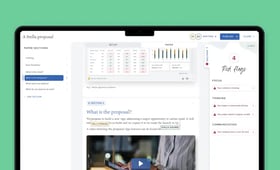Key takeaways
To run an effective board meeting:
- Define meeting goals clearly to guide preparation and focus.
- Prioritize strategic issues over routine items to drive value.
- Distribute high-quality pre-reads early to ensure that your directors are well-prepared.
- Facilitate balanced discussions to surface diverse perspectives.
- Use clear minute writing and follow-up systems to maintain accountability.
- Use board portals and AI tools to streamline the meeting process.
Board members’ ability to make the best possible use of meeting time is determined long before they take a seat at the boardroom table. Unstructured and overcrowded agendas, unprepared board members, and poor time management are some factors that can derail a board meeting. Research by Harvard found that only 64% of directors consider the quality of their board discussions to be high or very high.
In this article, we’ll show you how to run an effective board meeting and structure a strategic board agenda that makes every second of board time count. We’ll also explore implementing effective time management strategies, building consensus, and using tools to track meeting quality and board effectiveness.
What are the three primary objectives of board meetings?
A board meeting has three primary objectives: to provide oversight, ensure accountability, and make decisions. An effective board meeting is one in which board members deepen their understanding of organizational performance and make relevant, robust, and timely decisions.
Providing oversight and ensuring accountability
Effective boards monitor key metrics and ask tough questions when needed. They create accountability through regular check-ins and build trust by being predictable in their oversight. When management knows what boards care about and how they'll measure success, both sides can focus on performance instead of politics.
Making strategic decisions that drive organizational success
Boards advance strategy by focusing on the big moves rather than getting lost in operational details. They keep organizations agile by regularly challenging assumptions and adjusting course when conditions change. Every major decision gets tested against long-term goals instead of short-term pressures.
Why only 64% of directors rate their board discussions highly
A significant minority of directors feel discussions lack substance, pointing to wasted time in boardrooms across organizations. This creates an opportunity to redesign how boards spend their hours together — shifting from routine reports to strategic debates. Regular feedback and meeting redesigns can turn disengaged directors into active contributors.
How can you set up a successful board meeting?
The first step in understanding how to run an effective board meeting is recognizing the importance of preparation. Guidance from Deloitte suggests boards should consider “doing more to be prepared and engaged,” proactively seeking information through focused requests to management and their independent research and outreach.
How do you set clear board meeting objectives and mandates?
While the board provides long-term strategic direction and governance, the executive team is responsible for implementing the organization’s strategy and overseeing operational matters.
The organization must clearly define the corporate strategy, goals, and respective mandates of both the board and executive team. The key aim here is to ensure that all involved participants are aligned and understand what they're responsible for.
Define the objectives by linking them directly to your organization’s strategic priorities. Be specific; identify the decisions required, insights needed, or risks to assess. Share these objectives with directors in advance so expectations are clear and preparation is focused. Include the mandate in your agenda to prevent meetings from drifting into unproductive territory once discussions begin.
How do you create strategic board agendas that balance time and priorities?
Research by Board Intelligence and Cambridge Judge Business School found that boards spend just 32% of their meeting time on strategy, and that half of directors are unhappy with their board’s balance of conversation topics.
Use the jar of life method to help you prioritize. Tackle strategic topics first, then routine items, followed by ad-hoc but important matters. This prevents critical discussions from getting squeezed out by administrative work and last-minute issues that tend to expand and fill available time.
How do you write high-quality board papers and reports?
Research by Board Intelligence and the Chartered Governance Institute UK & Ireland shows board packs are getting longer, less valuable, and costlier to produce, despite 85% of companies now providing management with board reporting training and templates.
This suggests that, for many companies, templates and training aren’t working, and the investment they’re making in board reporting is not paying off. There are several things that organizations can do to tackle this and deliver high-quality board and management papers:
- Align the board and executive team around what a good board paper looks like, so it’s clear what’s expected. Then provide constructive and consistent feedback to report writers to help them deliver it.
- Ensure respondents receive a thorough brief outlining what the board wants them to cover in their paper to prevent time-consuming rewrites.
- Ensure that each paper has a structured executive summary that puts the key messages up front.
- Create report templates that map out the high-level questions that report-writers need to answer and provide them with a robust and logical structure to follow.
You can use a methodology like the Question-Driven Insight Principle to help guide your approach to board papers. You can also use technology to help management implement best practices.
Board Intelligence’s AI-powered report-writing tool Lucia, for example, gives management feedback and advice on their reports, pointing out where reports are too long, too backward-looking, or not covering the key topics. Our Board Reporting Assessment tool, used with the Board Reporting Calculator, will show if you’re getting the value from the board papers you’re putting in.
A high-quality KPI dashboard offers a visual snapshot of your organization or team’s performance and outlook, complementing the narrative content of the accompanying reports.
Essential pre-reading requirements and timeline best practices
Send pre-reads at least seven days before meetings to give directors time to absorb the content. Late materials will often turn board meetings into reading sessions instead of decision-making forums, wasting everyone's time and reducing the quality of discussion. Our research shows that 55% of directors receive their board packs, which are now well over 200 pages long, fewer than five days before the meeting.
How do you structure and manage the flow of a board meeting?
For the best meeting flow, give your management team clear guidance on what information the board needs for a productive discussion. And remember to tackle these critical topics early, when board members are still fresh and engaged.
Time management strategies for productive board sessions
We're seeing a growing gap between what boards need to accomplish and their available time. Our recent survey found that 91% of business leaders want their boards to reduce irrelevant discussions and focus more on the organization’s big-picture visions and goals.
First, allocate time limits for key agenda topics and enforce them consistently. This encourages presenters to be concise and helps discussions stay decision-focused. When meetings have clear boundaries, both preparation and participation improve.
Discussion facilitation techniques for better participation
Running effective board meetings involves clear communication, keeping discussions relevant, and ensuring that everyone has their say. Encourage participation through open questions and structured rounds, draw out quieter voices, and limit dominant ones.
Strategic focus: Spending 75% of time on value creation topics
Dedicate most meeting time to strategic discussions while keeping routine updates to brief time blocks. This shifts the board's role from passive information receiver to active strategic contributor, making better use of directors’ expertise and engagement.
Board decision-making process and consensus building
A board’s effectiveness ultimately comes down to how well it makes decisions. A study on NHS boards found that how they gathered information, built knowledge, and made decisions was more important than structure and composition.
Solutions that can improve board decision-making include improving the decision papers summarizing management’s analysis and recommendations, spending time with employees or external stakeholders, and asking questions beforehand.
What are the 5 main drivers of poor board decision-making?
Poor decisions often stem from:
- Information gaps.
- Bias.
- Dense materials.
- Dominant voices.
- Time constraints.
Critical thinking techniques to avoid groupthink
Board members must challenge common assumptions and explore alternatives. Board members need strong critical thinking skills to distinguish facts from interpretations, avoid biases, and prevent groupthink by maintaining independent perspectives and exploring diverse viewpoints.
Consensus-building strategies for strategic decisions
Take time to consider different perspectives instead of rushing to decisions. When directors feel heard and their concerns addressed, the final strategy reflects broader wisdom and gets stronger buy-in during implementation. Investing in alignment prevents problems later when executing difficult decisions.
Post-meeting actions and follow-up systems
Following up on decisions and monitoring progress is essential for accountability. Steps include finalizing and distributing meeting minutes, compiling documentation of decisions, and listing follow-up action items. These would involve assigning responsibilities, setting deadlines, and communicating key decisions to relevant stakeholders.
Monitor implementation by ensuring management follows through on strategic directives and reporting updates in future meetings. Finally, evaluate the meeting's effectiveness by gathering feedback to improve future board discussions and decision-making processes. This will help enhance board effectiveness overall.
Documentation best practices for board minutes
Minutes should capture the decisions made, the reasoning behind them, and who's responsible for the next steps. They should be clear enough that a new director joining next year can understand why the board made certain choices and how those decisions connect to the ongoing strategy.
In today’s digital world, knowing how to run an effective board meeting includes using modern tools. Board Intelligence’s Minute Writer lets you turn your notes and transcripts into board, committee, and meeting minutes in just a few clicks. Use our Minutes Calculator to uncover the hidden cost for your organization.
AI-powered tools for board minute writing
AI tools can draft meeting minutes from notes and recordings, capturing decisions and action items without hours of manual work. They help maintain consistent formatting and tone across meetings while freeing up administrative time for more strategic preparation.
Progress monitoring and board effectiveness measurement
It’s good practice to regularly assess your board’s processes, information, and meetings to identify opportunities for improvement, as part of a board effectiveness review. Use our Board Reporting Assessment tool to track progress on the quality of your board information and meetings, or consult our team for a bespoke board pack diagnostic.
Track metrics like meeting preparation time, discussion balance between strategic and operational topics, and director engagement scores. Regular measurement reveals patterns — like whether certain agenda formats produce better decisions or if preparation materials are reaching directors effectively — and guides targeted improvements.
Using board portal analytics for performance insights
Board portal software often includes analytics tools that can help you track board performance and engagement. It can track agenda focus, report quality, and attendance, while providing analytics that reveal usage patterns and board priorities. These insights can help you identify areas for improvement and ensure that all board members are informed and involved.
Technology tools for modern board meeting management
Modern boards can streamline governance using digital platforms, AI, and secure portals. These tools improve collaboration, efficiency, and decision quality.
Board portal software and digital meeting tools
Board portals provide a secure hub for agendas, papers, and meeting materials. They allow directors to review, annotate, and collaborate on documents in real time. Features like encrypted messaging and version control reduce risk while improving efficiency across dispersed boards.
AI-powered board reporting and assessment platforms
AI platforms analyze board reports to highlight trends, risks, and performance gaps. They can summarize complex data into actionable insights, saving directors time. Automated diagnostics also support board evaluations, offering objective benchmarks on governance quality and meeting effectiveness.
Agenda planning and board pack optimization tools
Agenda planning software can help you structure your meetings by balancing time between strategic and routine issues. These tools flag overloaded agendas and recommend re-prioritization. Pack optimization tools reduce document length, improve clarity, and ensure that directors receive focused, decision-ready information.
Use our assessment tool to find out how effective your board reporting is and get actionable tips on how to improve the quality of your board pack.
Start nowFAQs
-
What is the optimal length for a board meeting?
The optimal length is typically two to three hours. This duration allows enough time for in-depth discussions without overwhelming participants or leading to decision fatigue. Shorter meetings can still be effective if materials are distributed in advance and discussions remain focused. It’s not unusual for a board to have regular performance update calls in between quarterly strategic board meetings.
-
How far in advance should board papers be distributed?
Board papers should be distributed at least one week before the meeting. This allows board members to review key information and formulate thoughtful questions. Timely distribution improves engagement and ensures that discussions are more strategic and action-oriented.
-
How can we ensure balanced participation from all board members?
Encouraging balanced participation requires proactive facilitation and a culture of inclusivity. Chairs should invite input from less active members and manage dominant voices to ensure fair contribution. Using anonymous feedback tools, or the note-sharing feature within a board portal, can also help members share their insights more comfortably.
Can't find what you're looking for? Our friendly team are on hand to help.
Talk to our team


